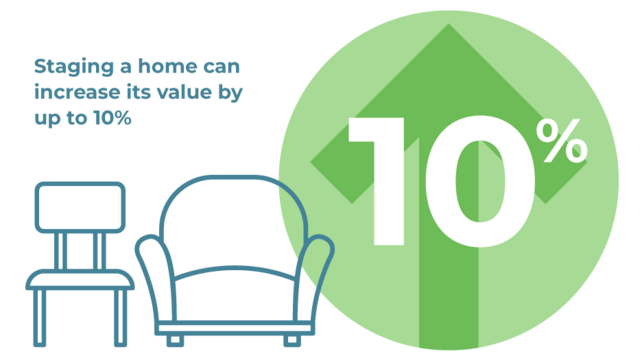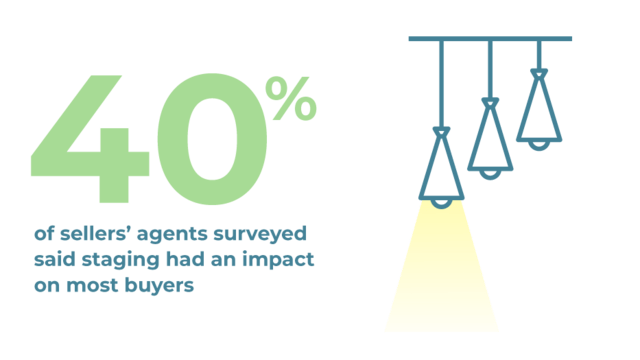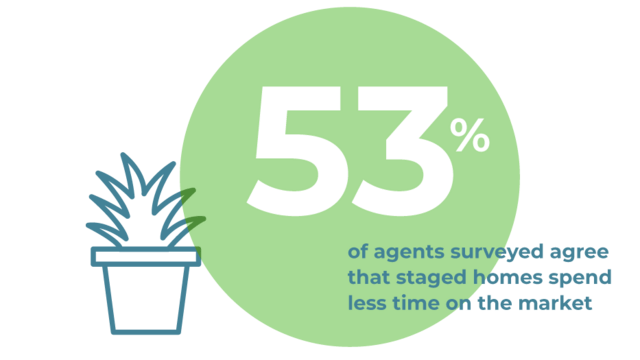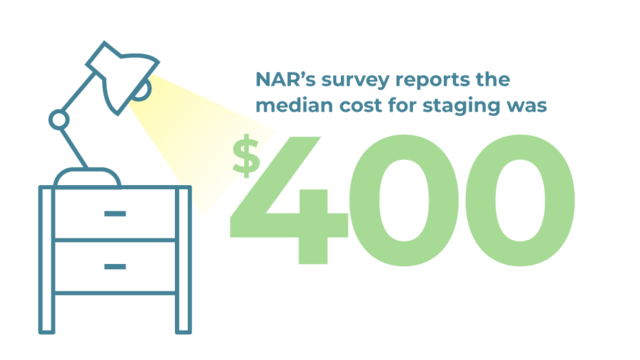
Staging a Home Like It’s 2022
July 18, 2022
Staging a home is likely to result in more showings and a better sale, most REALTORS® would agree. But staging in 2022 – affected by pandemic concerns, supply chain issues and time constraints – can be quite different than staging practices that first emerged in the 1970s. Early staging techniques focused on the three D’s - decluttering, depersonalizing and décor. Prices for services varied widely as did the expertise and inventory of the stagers. Now, staging is widely accepted and has adapted to meet homeowners’ needs.
Impact on Buyers and Sellers
A 2019 survey by the National Association of REALTORS® found that 28 percent of sellers’ agents routinely employ home staging to help move listings – most commonly the living room, master bedroom, kitchen and dining room. Twenty-two percent of sellers’ agents found that staged homes increased offers by one to five percent over similar homes, and 17 percent found that staging increased value by six to 10 percent. Buyers’ agents, according to the survey, also found staging helpful.

Forty percent said staging had an impact on most buyers; 52 percent said it had an effect on some buyers, but not always; and only six percent said staging had no effect.

Staging can also influence the time a property is on the market. Agents responding to NAR’s survey found that staged homes had less time on market. Twenty-eight percent cited slight decreases and 25 percent said staging greatly decreased time on market. Twelve percent found no effect and nine percent reported increased time on market.

How Much and Who Pays
In the early years of staging, there were few truly professional stagers. With staging more commonplace and in demand, there is an abundance of stagers with fees ranging from a few hundred dollars to thousands – some charge a percentage of the listing price. NAR’s survey found that 26 percent of sellers’ agents personally offered to stage their client’s home. When the seller paid for home staging, 18 percent paid before the home was listed and only five percent paid after the home sold. Seventeen percent of sellers’ agents offered a home staging service to their clients and 15 percent hired a professional home staging service. Either the seller or their REALTOR® pays for staging. NAR’s survey reports the median cost for staging was $400.

Since the 2019 survey, staging fees spiked in response to increased demand and the cost of maintaining a carefully curated inventory of furniture and décor items. A recent NAR article on home staging cited fees of up to eight to 10 percent of listing price.
A more cost-effective approach may lie in a new trend – virtual staging. Aimed at buyers who already are comfortable with online listings, virtual tours and layouts, virtual staging offers REALTORS® and their clients a way to declutter, depersonalize and update décor with edited photos. Stay-at-home orders and pandemic precautions gave rise to virtual staging first as consultations. Professional stagers would analyze photos and make suggestions for furniture removal and placement that homeowners could perform. As pandemic restrictions eased, virtual staging continued to evolve and is in demand, especially by sellers uncomfortable with strangers coming into their homes. Virtual staging may be less expensive and faster since changes are made via images instead of trucks full of furnishings. Time is money and virtual staging allows a faster home re-do. Instead of arranging for a furniture mover, a seller’s virtual stager can “move” items large and small with a mouse click.
Virtual staging fees vary with vendors and the services they offer. Some charge per room photo or by the number of items changed in each image. Others work for a flat fee for services as basic as simple image alterations to a virtual home makeover with consultations. Turnaround time can be as quick as 24-hours or longer for more extensive work.
Which is better? Whether staging is real, virtual or a combination of both, it can improve the visual appeal of an online listing. Since web appeal is today’s equivalent of curb appeal, it’s an important tool in competing for a buyer’s time for a personal visit. Virtual staging, much like curb appeal, entices a buyer to look but may lead to disappointment when viewed in person.
Staging Tips
Whether staging a home traditionally or virtually, here are a few must-do tips to quickly make a home shine online:
1. Clean
Floor to ceiling cleaning – with special emphasis on kitchen appliances and bathrooms – will not only make a home look its best, it assures potential buyers that the home is well maintained.
Potential buyers understand that a family lives in the house, but the goal is to make it so clean that a new family could feel comfortable moving in right away. Pick a place to hide away the half-used soap bar, toothbrushes, shampoo, and other toiletries every morning. In the kitchen, a new (dry) dishtowel, uncluttered countertops, and sparkling surfaces involve minimal effort yet leaves a lasting good impression.
2. Declutter
Items that won’t be moved to or fit in a new home should be removed – store them temporarily or donate. Experts say closets should contain only matching hangers and current-season clothing. Purge outdated, no longer worn items to donate and store the rest. Local thrift stores will welcome always in demand household items and clothing. Bonus tip: Get a receipt for a deduction at tax time.
Reduce the number of items on bookshelves and visible cabinet shelves. Carefully select what remains.
Don’t forget to declutter the pantry removing out-of-date food.
Pack away games and hobby materials.
Garages and storage buildings can easily become the repository of clutter. At least organize the contents to create as much space as possible.
Remember, the more uncluttered, empty space, the better. Allow potential buyers to see the amount of space without distraction
3. De-Pet
Pets are beloved family members in many homes. There are homebuyers, however, who are allergic to or afraid of the most adorable pets. Find a place to keep pets during showings and a place to store bowls, beds and litter boxes. Anything that remains in view, like a fish tank, should be immaculately clean. Virtual stagers can remove pet items like crates, beds, litter boxes, and food bowls from room photos. It’s almost like Princess and Peppy were never there.
4. Depersonalize
Go beyond removing the refrigerator magnets, family photos, and kids’ artwork. Look around and store most items that communicate who lives there. Toys, cosmetics, and souvenirs should be stored.
Once the house is depersonalized, look for a few things to add back to keep it from appearing too sanitized. A trophy in a child’s room or a nice collectible may help a buyer visualize a happy family – like theirs – living in the home.
5. Decor
Décor is an expression of the current homeowner’s style but, if the goal is making a home attractive to a buyer, décor should be as neutral as possible. Rooms with an obvious theme like tropical trees and plants or everything farmhouse should be staged with a more neutral look by removing some themed items.
Pack away religious items and political messages. The same goes for items with sports logos. Aubie and Big Al deserve a little vacation. Collections – especially large ones – can distract potential buyers. Pack collections away until they reach their new home.
For more real and virtual home staging tips, visit investopedia.com and The Top Dos and Don'ts of Virtual Staging.